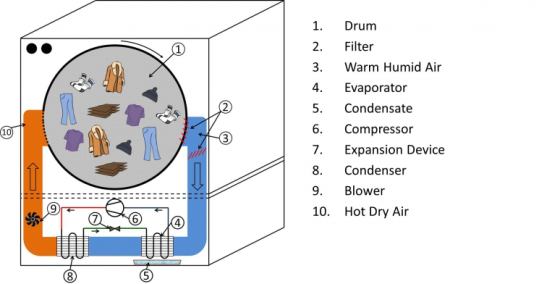
What They Are & How They Work
A heat pump (HP) clothes dryer seems like the kind of rube-Goldberg device that MacGyver might have contrived. Imagine a residential dehumidifier, duct tape, some flexible duct, and an old clothes dryer with a broken heating element. It sounds like a monstrosity to terrorize your children, but might it dry clothes? The short answer: yes.
Most of you have walked close enough to the outside portion of a window air-conditioner to feel the warm dry breeze blowing off the coils. By now, many are aware that this arrangement can be reversed. An HP can move heat from the cool outdoors to the house’s interior. The same principle can be used to dry clothes.
Two HP dryer designs are available: The simplest, “vented” HP dryer design, vents warm, moist air to the outdoors like a regular dryer. “Ventless” units recycle the warm, moist air back to the “cold coils” (evaporator) of the HP which dries the air before it’s reheated and returned to the clothes drum. The unit must be located near a drain to collect condensate water from the evaporator coil.
Should You Consider One?
HP dryers are 30% (vented HP dryers) to 50% (best ventless models) more efficient than standard dryers. Other considerations include:
- IMC 2012 exempts ventless dryers from clothes dryer exhaust requirements; saving energy to heat make-up air as a bonus.
- Ventless can be placed in locations far from an exterior wall. New laundromats may avoid building exhaust plenums to collect exhaust from strings of dryers.
- Some HP dryers operate at lower fabric temperatures which is gentler on clothing.
- Drying time can be greater than a standard dryer, though this isn’t true for all models or fabric types.
Summary: A 2010 study[1] of vented HP dryers concluded that cost would need to be reduced by 11% for these dryers to be cost effective—even for families with heavy laundry use. Since then, several ventless models have been registered with ENERGY STAR (14 qualifying units by four manufacturers) with costs two to three times that of a standard dryer. On energy savings alone, it remains difficult to justify that added expense except for families or commercial laundries with heavy use.
[1] Meyers, Steve etal. “Do Heat Pump Clothes Dryers Make Sense for the U.S. Market?”



